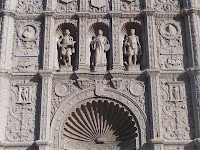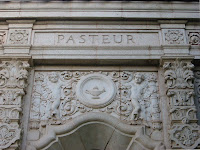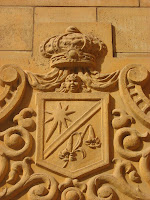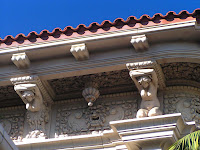
I have been so negligent about the blog of mine that I might have forgotten how to do it. Let's find out.

On a recent trip to Phoenix, AZ, I found myself looking at quite a lot of Spanish Revival architectural sculpture, particularly examples of what I'll loosely call Churrigueresque, a style of ornamentation named after a family of Spanish architects who were active from the mid 1600s to the mid 1700s. The style, a permutation of Renaissance/Baroque taken to the extreme became the style of choice for the Spanish in their Nw World colonies. Starting in Mexico it traveled south through Peru and Brazil (okay, so the Portuguese did it too) and north to New Mexico and California. A versions of it was picked up by the architect Bertram Goodhue for the Panama Pacific Exposition (PPE) in 1915 and quickly spread through the Southwest and Florida (see "The Spanish were there too" - a blog of the future). The 1920s saw a number of significant books published on the style and its roots. Which brings to my mind the topic of my library. Which I will blog about soon.

After viewing several major and minor 1920s examples, and having seen Goodhue's remaining works at Balboa Park in San Diego (where the PPE was held) I set about trying to analyze which of the various features in the sculpture on these buildings was based on Spanish precedent and which were purely of the 20th Century. What I found to be the common elements of both the Classical and modern versions of the style were an abundance of lavish detail, most of it curvilinear in nature, much of it is plant based, that usually having in's origin in a stylized, decorated pot, vase or planter of some sort.

The human elements consisted of some combination of full sized figures in niches, busts, cameo portraits in round frames and the frequent inclusion of cherubs, putti and angels. Often disembodied heads pop out of juncture points (that is, where two of more elements, often plant in nature meet.) It is not uncommon to find dragons, griffins satyrs and other mythical creatures in the mix. it appears to me that the 20th Century sculptors, probably under the direction of the architects would on occasion employ a "primitive" style to some of their figures, harkening back to an age where anatomy was neither understood nor studied.

Shields, coat-of-arms and cartouches are liberally sprinkled almost everywhere and are usually contain obvious or undecipherable symbolic designs. The use of a crown as a . . ... crowing element goes back to the early Spanish examples where it is used to indicate either secular or religious royalty. It is used during the Revival years on both churches and

Now lets see if I can find some pictures to explain what the heck I just said.
